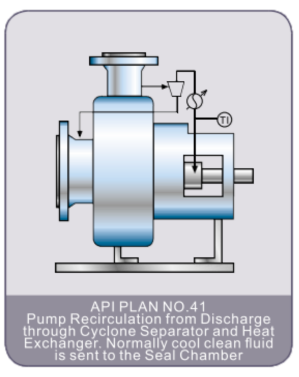
API Plan 41
Overview:
In API Plan 41 the pumped fluid is typically routed from the pump discharge, through a cyclone separator and heat exchanger, and injected into the mechanical seal. This API Plan is a combination of API Plan 21 and API Plan 31.
Advantages:
- Self-venting
- Cooling of the process fluid which is then used to lubricate and cool the mechanical seal.
- Removal of particles using a cyclone separator.
Disadvantages:
- Not all particles can be separated with a cyclone separator (API Plan 31). The particle weight must be at least double that of the fluid for the particles to effectively separate in the cyclone separator.
- Not suitable for extremely dirty applications, such as slurries.
- Increased cost and maintenance
Best For:
- Hot applications containing particulates (i.e. solids)
- Lowering the vapor pressure margin of the pumped fluid
- Clean process fluids – free of contaminants and abrasives
- Process fluids not susceptible to polymerization or “setting-up” at ambient or lower temperatures
- Fluids containing particles with relatively heavier (i.e. double) specific gravities than that of the fluid (e.g. water with sand).
Best Practices:
- Calculate the pressure differential between the pump discharge pressure and the seal chamber pressure to ensure positive flow into the seal.
- Isolation valves should not be installed in the flush piping. If such a valve is installed in the flush line, there poses the risk of it being closed and preventing flow to the seal. In such an event, the seal life will be drastically reduced and subsequently fail due to the lack of cooling and lubrication.
- Routine Maintenance
- Record the temperature of the following. Compare to previous records to trend performance.
- Process fluid into heat exchanger
- Process fluid out heat exchanger
- Cooling water into heat exchanger
- Cooling water out heat exchanger
- Backflush the heat exchanger at least monthly. If cooling water quality is poor, backflush the heat exchanger weekly or more frequently based on operating experience. Backflushing the heat exchangers will help prevent and mitigate fouling and clogging within the heat exchanger.
- Check the piping or tubing temperature against that of the pump. If the Plan 31 flush piping is appreciably cooler than the pump temperature, there may be an obstruction in the flush piping.
- Additionally, check the temperature both upstream and downstream of the cyclone separator. If the temperature downstream of is appreciably cooler, the cyclone separator may be obstructed. Immediate action is needed to clear the obstruction. If found obstructed, the seal is likely damaged and needs to be replaced.
- Where practical, such as during a pump or seal repair/replacement, the interior of the cyclone separator should be visually inspected. Over time, the particles within the fluid wear the interior of the cyclone separator considerably, resulting in decreased separator performance, potential separator failure, and subsequent mechanical seal failure.
- Record the temperature of the following. Compare to previous records to trend performance.


